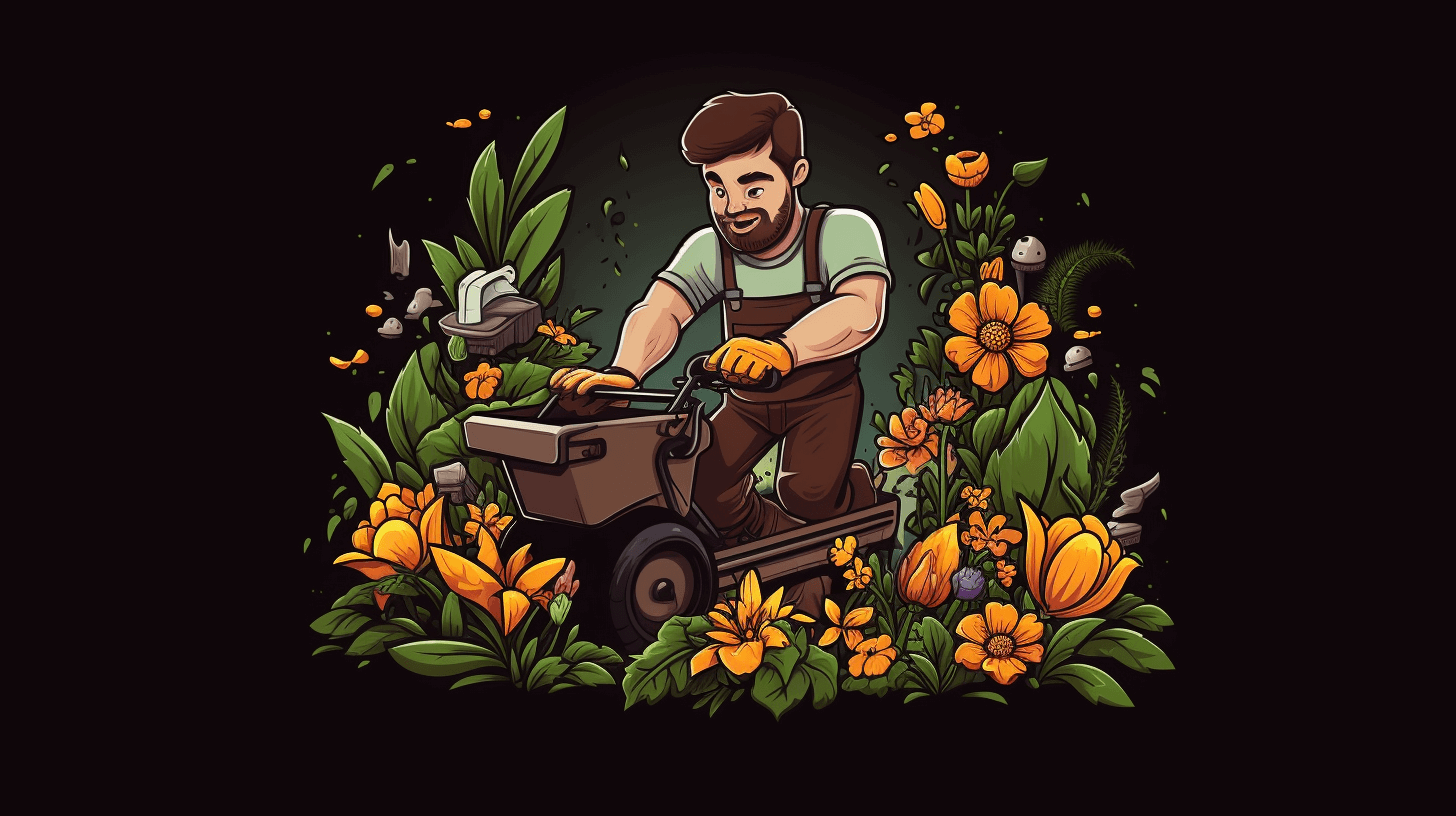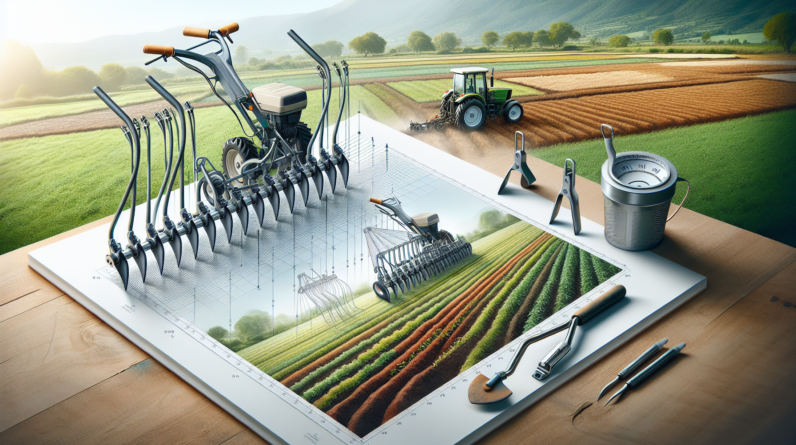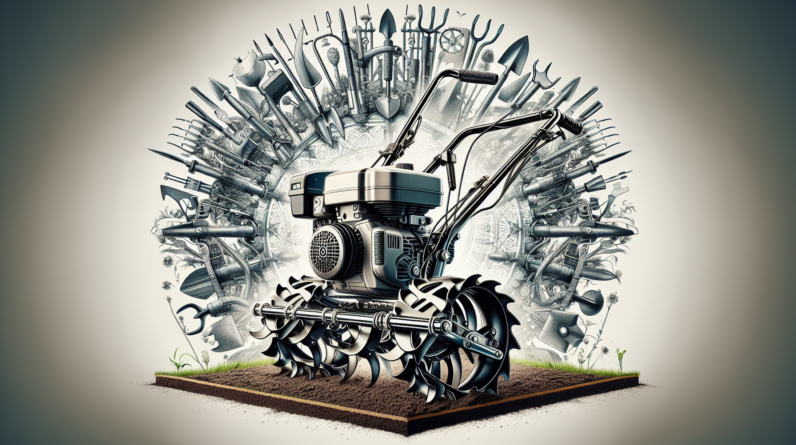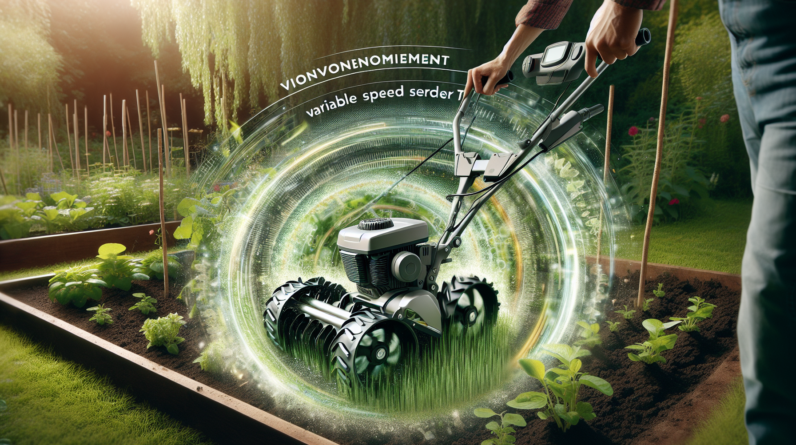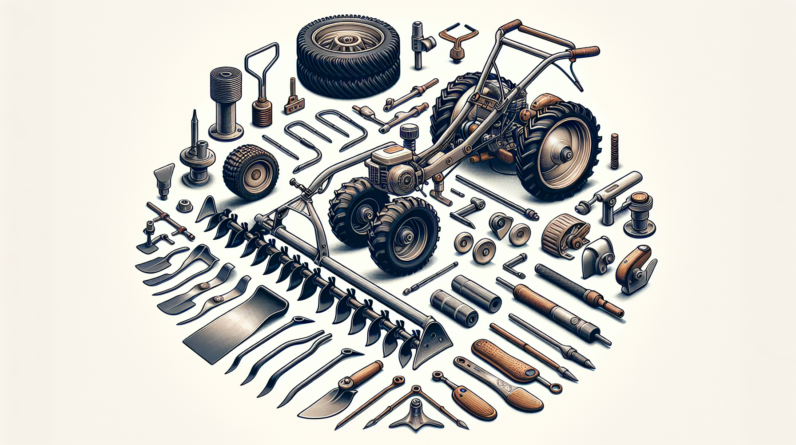
Imagine having a garden that not only looks beautiful but also produces an abundance of fresh vegetables and flowers. With the help of walk-behind garden tillers, this dream can easily become a reality. These innovative machines are designed to effortlessly turn and aerate the soil, making it easier for plants to grow. Whether you are an experienced gardener or just starting out, walk-behind garden tillers can save you time and effort, while ensuring your garden thrives. Say goodbye to tiring manual tilling and say hello to a vibrant and thriving garden with the assistance of these amazing tools.
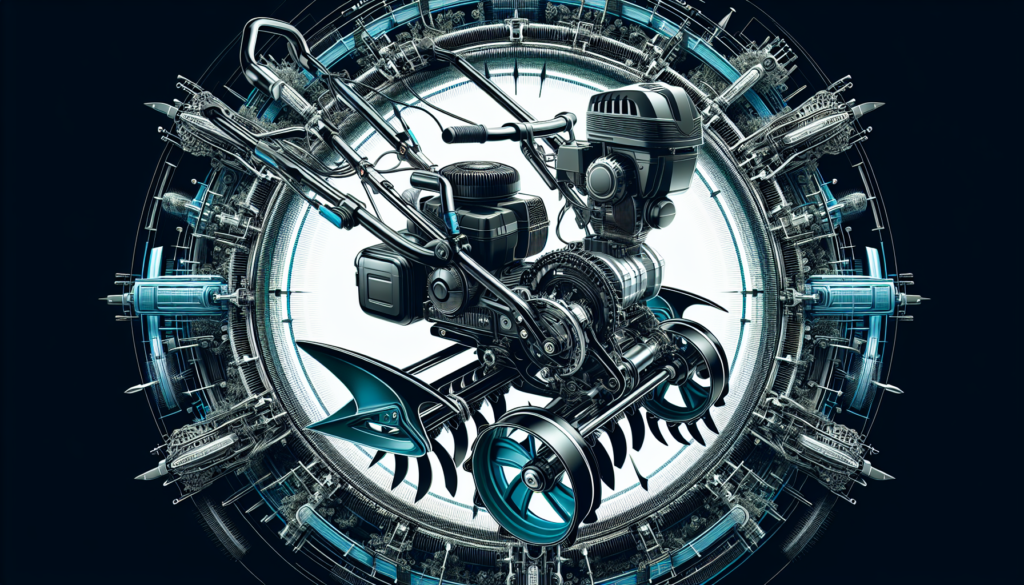
Types of Walk-Behind Garden Tillers
Front-Tine Tillers
front-tine tillers are ideal for small to medium-sized gardens and are commonly used for light to medium-duty tasks. These tillers have the tines located in front of the wheels, which means they are easier to maneuver in tight spaces. Front-tine tillers are perfect for breaking new ground, mixing in compost or fertilizer, and cultivating soil.
Rear-Tine Tillers
rear-tine tillers are more heavy-duty and powerful compared to front-tine tillers. Unlike front-tine tillers, the tines of rear-tine tillers are located behind the wheels. This design provides better traction and stability, making them suitable for larger areas and tougher tasks. Rear-tine tillers are great for breaking up compacted soil, preparing large garden beds, and incorporating tough plant debris.
Mid-Tine Tillers
Mid-tine tillers combine the features of both front-tine and rear-tine tillers. The tines on mid-tine tillers are located in the center, between the wheels. This design offers improved maneuverability and balance, making them versatile for various garden sizes. Mid-tine tillers are effective for cultivating established garden beds and maintaining existing gardens.
Factors to Consider When Choosing a Walk-Behind Garden Tiller
Size of the Garden
The size of your garden plays a significant role in determining the type of walk-behind garden tiller you need. If you have a small garden, a front-tine tiller may be sufficient. For larger gardens or extensive landscaping, a rear-tine tiller or a mid-tine tiller would be more suitable.
Type of Soil
Consider the soil type in your garden. If you have loose, well-drained soil, a front-tine tiller can handle the task efficiently. However, if you have compacted or clayey soil, a rear-tine tiller with greater power will be necessary to break through and loosen the soil effectively.
Tilling Depth
The tilling depth required for your garden is another factor to consider. Front-tine tillers typically have shallower tilling depths compared to rear-tine tillers. If you plan to dig deeper into the soil, a rear-tine tiller would be a better choice.
Tilling Width
The tilling width refers to the width of the area a tiller can cover in one pass. Consider the size of your garden beds and the efficiency you need when determining the desired tilling width. For smaller beds, a narrow tilling width may be sufficient, while larger beds may require wider tilling widths.
Engine Power
Engine power is an essential factor to consider, as it determines the capability of the tiller. More powerful engines can handle tough soil conditions and provide better performance. Front-tine tillers usually have lower horsepower engines compared to rear-tine tillers.
Weight and Maneuverability
The weight and maneuverability of the tiller are crucial, especially if you have limited strength or maneuvering space. Lighter tillers are easier to handle, while heavier tillers provide better stability. Consider your physical capabilities and the terrain of your garden when deciding which tiller would be easier for you to maneuver.
Additional Features
Some tillers come with additional features that can enhance your gardening experience. These features may include adjustable handles, forward and reverse functionality, adjustable tilling depth settings, and attachments for specific gardening tasks. Consider the extras that would benefit you and make gardening more efficient and enjoyable.
Preparation and Safety Measures
Clearing the Area
Before using a walk-behind garden tiller, it is essential to clear the area of any debris, rocks, or large objects that may obstruct the tiller’s path. Remove any plants, weeds, or roots that could get caught in the tiller’s tines. This ensures a safer and more efficient tilling process.
Safety Gear
It is crucial to prioritize safety when operating a walk-behind garden tiller. Wear appropriate safety gear, including protective eyewear, sturdy boots, long pants, and gloves. These will protect you from flying debris and potential injuries. Also, ensure that you have read and understood the manufacturer’s safety guidelines and instructions before starting the tiller.
Proper Use of Walk-Behind Garden Tillers
Preparing the Tiller
Before starting the tiller, make sure it is properly assembled and all components are secure. Check the oil and fuel levels, and ensure that the tines are in good working condition. Familiarize yourself with the controls and ensure that the tiller is on stable ground.
Starting the Engine
Follow the manufacturer’s instructions for starting the tiller’s engine. Typically, this involves priming the engine, setting the choke, and pulling the starter cord. Take care not to yank the cord forcefully to avoid injury. Once the engine starts, allow it to warm up for a few minutes before engaging the tines.
Operating the Tiller
When operating the tiller, maintain a firm and comfortable grip on the handlebars. Walk behind the tiller at a steady pace, allowing the tines to rotate and till the soil. Avoid pushing the tiller too fast or applying excessive downward pressure, as this can strain the engine and impact tilling effectiveness.
Adjusting the Depth and Width
If your tiller allows for depth and width adjustment, optimize these settings based on the specific task and soil conditions. Ensure the tiller is set to the appropriate depth to achieve efficient tilling without causing unnecessary strain on the tiller or yourself. Start with shallower settings and gradually increase depth as needed.
Avoiding Obstacles
While operating the tiller, be mindful of any obstacles in the garden, such as rocks, large roots, or underground pipes. These can cause damage to the tiller or pose safety risks. If you encounter an obstacle, stop the tiller, assess the situation, and remove or work around the obstacle before proceeding.
Maintaining a Steady Pace
Maintaining a steady and consistent pace when operating the tiller helps ensure even tilling and prevents excessive stress on the engine. Avoid speeding up or slowing down abruptly, as this can affect the quality of tilling and may lead to uneven results.
Tilling Techniques
When tilling, it is best to work in straight lines or slightly overlapping rows. This helps avoid missing areas and ensures even coverage. Take care not to make too many passes over the same area, as this can lead to over-tilling, which may negatively impact soil structure.
Removing Weeds and Roots
If you encounter weeds or roots while tilling, it is recommended to stop the tiller, manually remove them from the tines, and dispose of them properly. This prevents weed or root fragments from spreading throughout the tilled area and potentially regrowing.
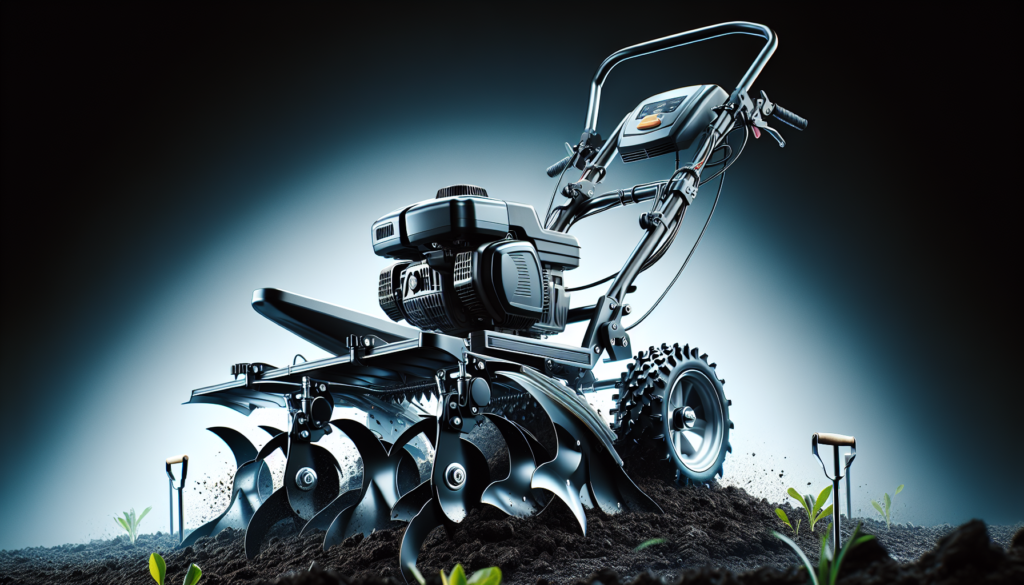
Maintenance and Care
Cleaning the Tiller after Use
After using the tiller, it is essential to clean it thoroughly to remove any dirt, debris, or plant material that may be stuck to the machine. Use a brush or compressed air to clean the tines, engine, and any other accessible parts. This helps prevent rust and ensures that the tiller remains in good working condition.
Sharpening and Replacing Blades
Regularly inspect the tines or blades of the tiller for signs of wear or damage. Sharpen or replace dull or damaged blades as needed. Sharp blades provide efficient tilling and reduce strain on the tiller’s engine.
Checking and Changing Oil
Check the oil levels regularly and top up if necessary. Additionally, follow the manufacturer’s recommendations for oil change intervals. Clean and replace the oil periodically to ensure the tiller’s engine operates at optimal performance and remains well-lubricated.
Inspecting and Lubricating Parts
Inspect the tiller’s mechanical components, such as belts, pulleys, and bearings, for any signs of wear, damage, or lack of lubrication. Lubricate these parts as recommended by the manufacturer to maintain smooth operation and prevent premature wear.
Storing the Tiller Properly
When not in use, store the tiller in a clean and dry location, away from extreme temperatures, moisture, and direct sunlight. Proper storage prevents rust, extends the lifespan of the tiller, and ensures it is ready for use when needed. Follow the manufacturer’s guidelines for long-term storage and any specific procedures for winterizing the tiller.
Benefits of Using Walk-Behind Garden Tillers
Efficient Garden Preparation
Walk-behind garden tillers significantly speed up the process of preparing garden beds and loosening the soil. These powerful machines can quickly break up compacted soil and evenly distribute compost or fertilizer, ensuring your plants have the best conditions to grow.
Time and Energy Saving
Using a walk-behind garden tiller saves time and energy compared to manual tilling. Instead of spending hours with a hand tiller or shovel, a walk-behind tiller can cover a larger area in less time, allowing you to focus on other gardening tasks.
Improved Soil Health
Tilling the soil with a walk-behind tiller helps improve soil structure, aeration, and drainage. By breaking up compacted soil, the roots of your plants can penetrate deeper and access nutrients and water more easily. Enhanced soil health promotes healthier plant growth and better overall garden productivity.
Versatility in Tilling Tasks
Walk-behind garden tillers offer versatility in tackling various gardening tasks. Depending on the tiller type and attachments available, you can cultivate new garden beds, maintain existing ones, mix in amendments, remove weeds, or prepare your garden for winter. The ability to switch between tasks with a single machine saves both time and money.
Cost-Effective in the Long Run
While a walk-behind garden tiller may require an initial investment, it can prove cost-effective in the long run. These machines, when properly maintained, can last for many years, saving you money on frequent manual tilling or hiring professional services. Investing in a quality tiller also ensures efficient garden maintenance and higher yields year after year.
Best Practices for Walk-Behind Garden Tiller Usage
Regular Maintenance and Repairs
To ensure optimal performance and longevity of your walk-behind garden tiller, it is crucial to perform regular maintenance and address any repairs promptly. Regularly inspect and clean the tiller, sharpen or replace blades, check oil levels, and lubricate moving parts. Following the manufacturer’s maintenance schedule and guidelines will help prevent costly repairs and extend the lifespan of your tiller.
Proper Usage Techniques
Using the tiller correctly is essential for both efficient tilling and reducing the risk of damage or injury. Familiarize yourself with the manufacturer’s instructions, safety guidelines, and recommended operating techniques. Practice proper depth and width adjustment, avoid aggressive tilling techniques, and pay attention to your surroundings to prevent accidents.
Top Walk-Behind Garden Tillers in the Market
Brand A Walk-Behind Tiller
Brand A offers a range of high-quality walk-behind tillers known for their durability and performance. These tillers come in various sizes and power options to suit different garden needs. The Brand A Walk-Behind Tiller features adjustable tilling depth and width settings, allowing for precise customization. With its reliable engine and sturdy construction, it is a popular choice among gardeners of all experience levels.
Brand B Walk-Behind Tiller
Brand B specializes in robust and powerful walk-behind tillers designed for larger gardens or demanding tasks. Their tillers boast heavy-duty construction and advanced features that deliver exceptional performance. The Brand B Walk-Behind Tiller features a variable speed control system and a wide tilling width, making it a top choice for professional landscapers and avid gardeners.
Brand C Walk-Behind Tiller
Brand C offers innovative and user-friendly walk-behind tillers suitable for both residential and commercial use. Their tillers are known for their ease of operation, excellent maneuverability, and superior performance. The Brand C Walk-Behind Tiller features a compact design with adjustable handles and offers versatile tilling options for various soil types and garden sizes.
Conclusion
In conclusion, walk-behind garden tillers are invaluable tools for every gardener, whether you have a small backyard plot or a larger garden. Understanding the different types of tillers available, as well as considering factors such as garden size, soil type, tilling depth, and width, engine power, weight, and additional features, will help you choose the right tiller for your specific needs.
Prioritizing safety measures, proper use techniques, and regular maintenance and care will ensure optimal performance and longevity of your tiller. By using walk-behind garden tillers, you can efficiently prepare your garden, save time and energy, improve soil health, and enjoy the cost-effective benefits they offer. With the wide range of walk-behind garden tillers available in the market, such as those offered by Brand A, Brand B, and Brand C, you can find the perfect machine to elevate your gardening experience and achieve impressive results.
